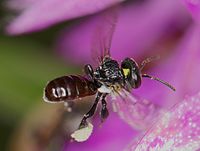
Photo from wikipedia
Abstract To date, regulatory pesticide risk assessments have relied on the honey bee (Apis mellifera L.) (Hymenoptera: Apidae) as a surrogate test species for estimating the risk of pesticide exposure… Click to show full abstract
Abstract To date, regulatory pesticide risk assessments have relied on the honey bee (Apis mellifera L.) (Hymenoptera: Apidae) as a surrogate test species for estimating the risk of pesticide exposure to all bee species. However, honey bees and non-Apis bees may differ in their susceptibility and exposure to pesticides. In 2017, a workshop (‘Pesticide Exposure Assessment Paradigm for Non-Apis Bees’) was held to assess if honey bee risk assessment frameworks are reflective of non-Apis bee pesticide exposure. In this article, we summarize the workshop discussions on bumble bees (Bombus spp.). We review the life history and foraging behavior of bumble bees and honey bees and discuss how these traits may influence routes and levels of exposure for both taxa. Overall, the major pesticide exposure routes for bumble bees and honey bees are similar; however, bumble bees face additional exposure routes (direct exposure of foraging queens and exposure of larvae and adults to soil residues). Furthermore, bumble bees may receive comparatively higher pesticide doses via contact or oral exposure. We conclude that honey bee pesticide risk assessments may not always be protective of bumble bees, especially queens, in terms of exposure. Data needed to reliably quantify pesticide exposure for bumble bees (e.g., food consumption rates, soil residue levels) are lacking. Addressing these knowledge gaps will be crucial before bumble bee exposure can be incorporated into the pesticide risk assessment process. Because bumble bees exhibit appreciable interspecific variation in colony and behavioral characteristics, data relevant to pesticide exposure should be generated for multiple species.
Journal Title: Environmental Entomology
Year Published: 2018
Link to full text (if available)
Share on Social Media: Sign Up to like & get
recommendations!